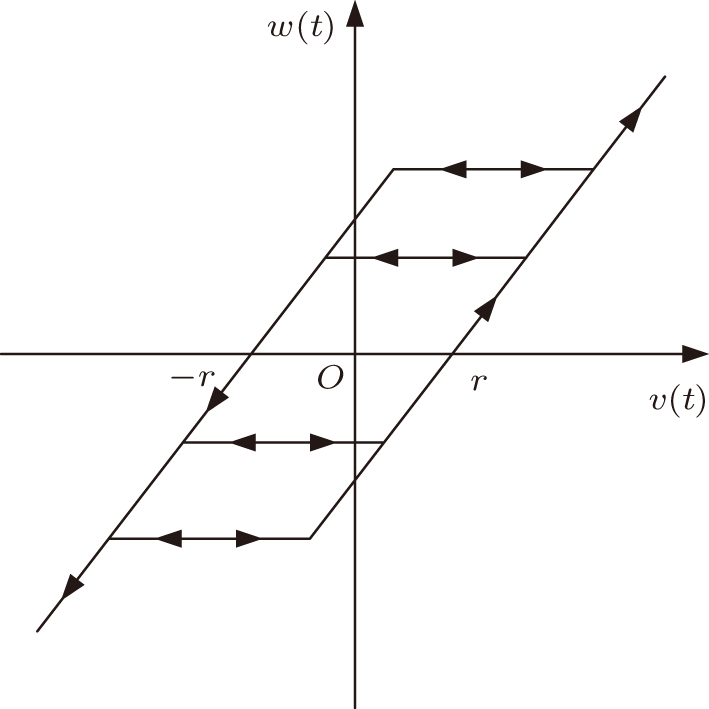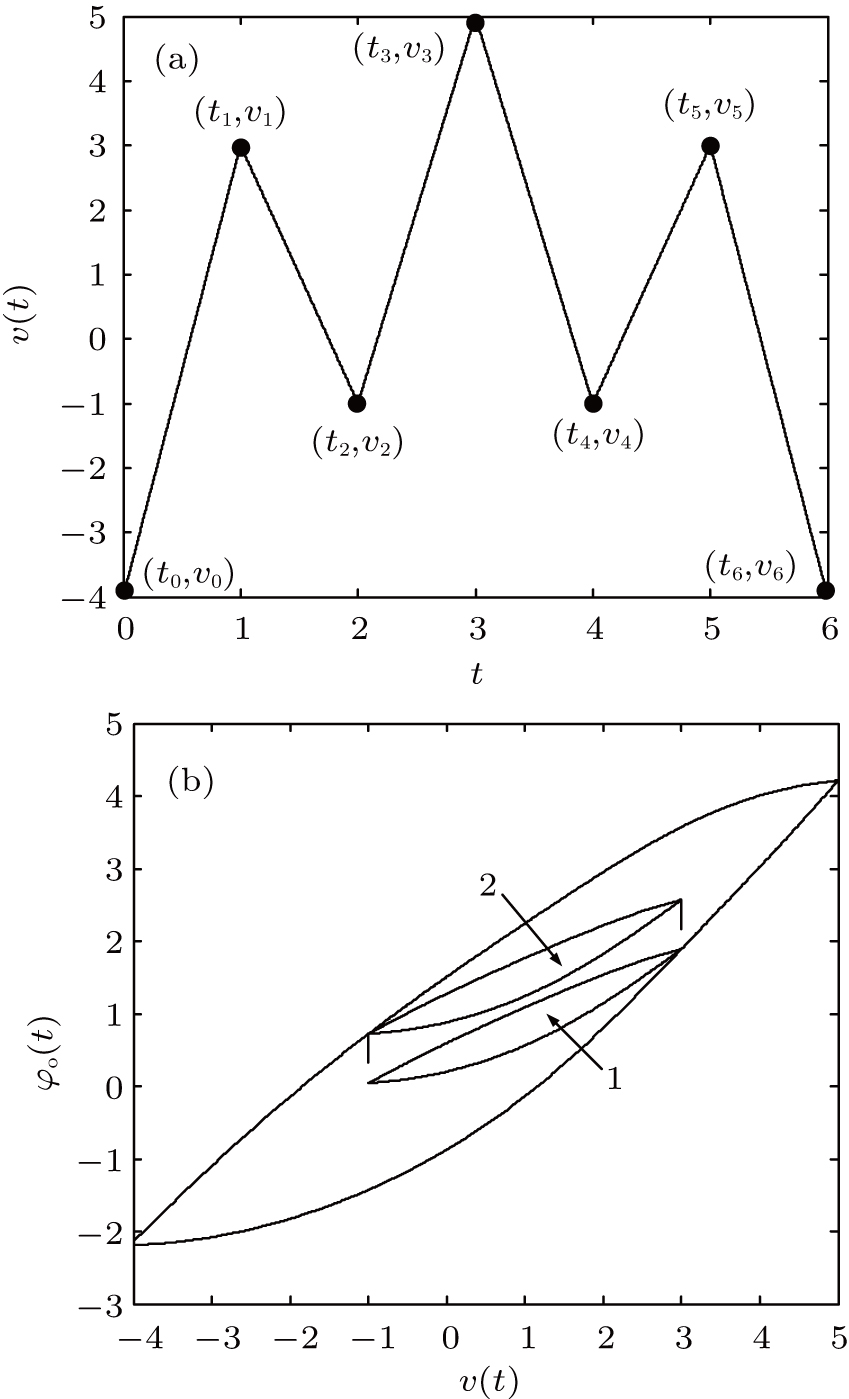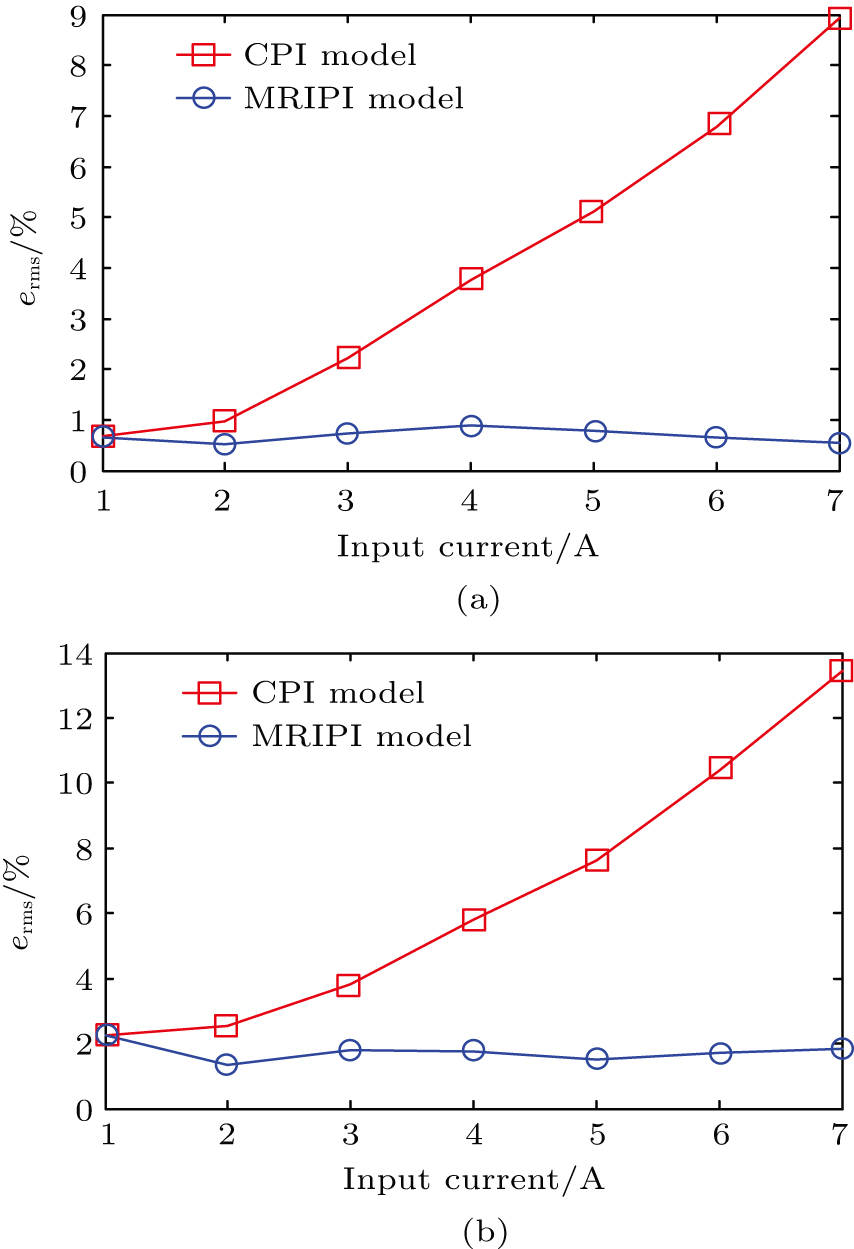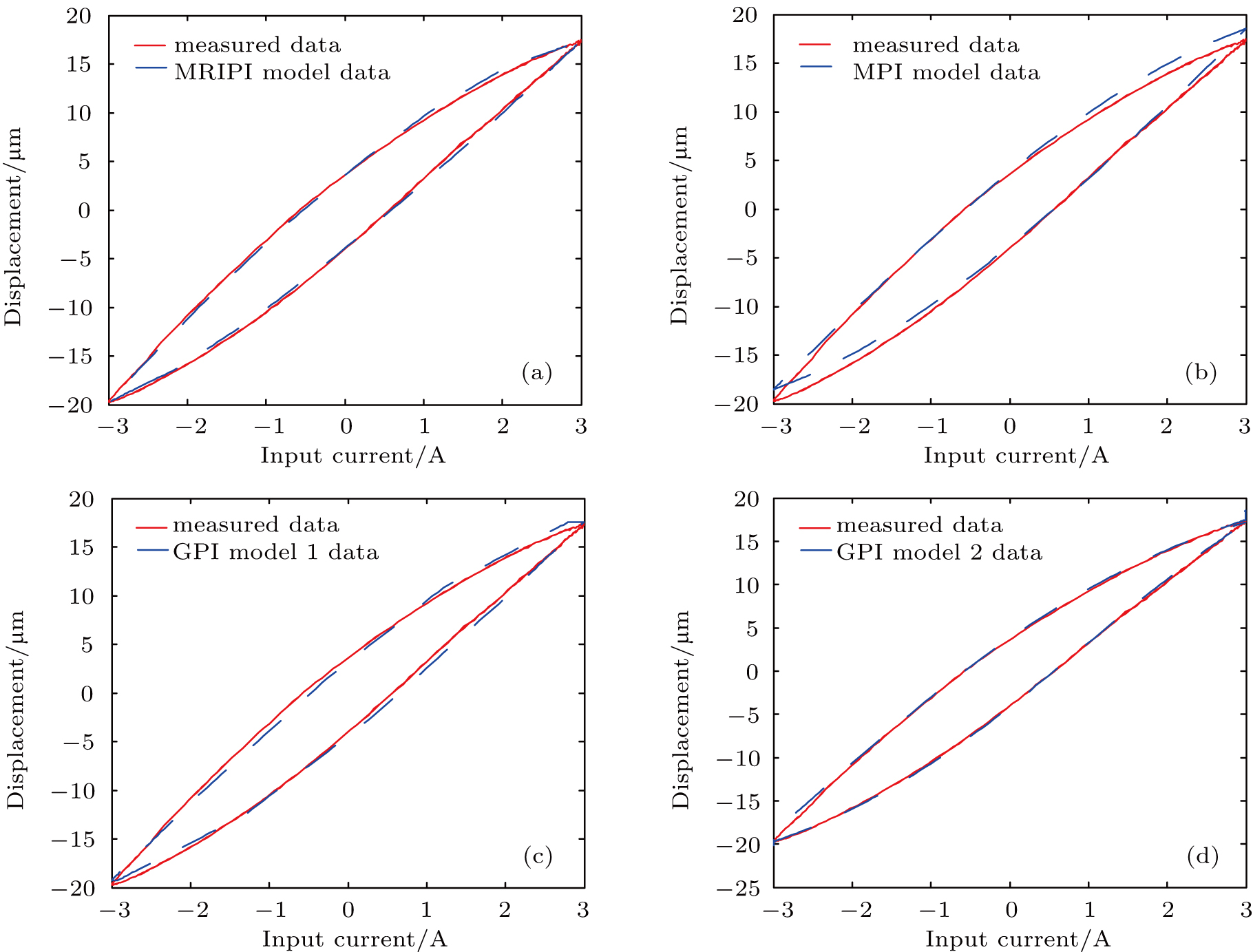† Corresponding author. E-mail:
This paper presents a modified rate-independent Prandtl–Ishlinskii (MRIPI) model based on the Fermi–Dirac distribution for the asymmetric hysteresis description of magnetostrictive actuators. Generally, the classical Prandtl–Ishlinskii (CPI) model can hardly describe the asymmetric hysteresis. To overcome this limitation, various complex operators have been developed to replace the classical operator. In this study, the proposed MRIPI model maintains the classical operator while a modified input function based on the Fermi–Dirac distribution is presented to replace the classical input function. With this method, the MRIPI model can describe the asymmetric hysteresis of magnetostrictive actuators in a relatively simple mathematic format and has fewer parameters to be identified. A velocity-based sine cosine algorithm (VSCA) is also proposed for the parameter identification of the MRIPI model. To verify the validity of the MRIPI model, experiments are performed and the results are compared with those of the existing modeling methods.
Generally, magnetostriction is the deformation of materials influenced by an external magnetic field. The magnetostrictive effect was first presented by James Joule in 1842,[1] and nowadays the magnetostrictive materials are widely used for micro/nano-level actuation. Due to the characteristics of fast response, high resolution, and high force capacity, magnetostrictive actuators are designed for various applications, such as high speed precision milling machines, hydraulic valves, and active damping systems.[2–4] However, the input–output property of magnetostrictive actuators exhibits considerable hysteresis nonlinearities which deeply reduce their accuracy. Furthermore, their hysteresis curves tend to be asymmetric when driven by moderate or higher amplitude excitations.[5–7]
To address this problem, a number of hysteresis models have been proposed to describe and compensate for the hysteresis of magnetostrictive actuators. The physics-based models are generally derived on the basis of a physical measure, such as magnetization, stress–strain, and energy principles.[8–12] They are usually presented in a complex mathematic format and thus are difficult to invert. Therefore, many phenomenological models, such as Preisach[13–16] and Prandtl–Ishlinskii (P–I) models,[17–20] are proposed. They can be regarded as a superposition of hysteresis operators in relatively simple mathematic formats. Furthermore, P–I models are analytically invertible so that it is convenient to use them to compensate for the hysteresis of magnetostrictive actuators.[18,21,22]
The classical Prandtl–Ishlinskii (CPI) model is composed of a series of classical operators and an input function. Generally, it can only efficiently describe the symmetric hysteresis nonlinearity. To overcome this limitation, much research focuses on the optimization of the classical operators. Therefore, various complex operators have been developed to replace the classical operator. Al Janaideh et al. proposed a generalized Prandtl–Ishlinskii (GPI) model established by a superposition of generalized hysteresis operators.[17, 22] These generalized operators are formulated by the relatively complex envelope functions, and thus the GPI model can describe the asymmetric and saturated hysteresis properties of different smart actuators. Guanqiao Shan et al. studied the hysteresis properties of the voice coil motor experimentally and introduced a modified GPI model to compensate for its asymmetric hysteresis.[23] Kuhnen combined a conventional P–I operator and a dead-zone operator which is used to describe memory-free nonlinearities, and established a new P–I model to describe and compensate for the asymmetric hysteresis of magnetostrictive actuators.[24] These models can describe the asymmetric hysteresis exhibited by magnetostrictive actuators. However, limitations exist in the complex operators when inverting these models mathematically. To balance the modeling performance and model complexity, Guoying Gu et al. focused on the optimization of the input function and introduced a modified Prandtl–Ishlinskii (MPI) model by replacing the linear input function with polynomial functions.[18, 21] The MPI model only changes the input function and maintains the CPI operator. Therefore, it has a relatively simple mathematic format. More recently, Jinqiang Gan et al. added a quadratic polynomial on the basis of the CPI model.[25] This model could describe both rate-independent and rate-dependent hystereses in piezoelectric actuators. Micky Rakotondrabe proposed a multivariable hysteresis model based on the extension of the CPI (monovariable) model.[26] This model avoided the model inversion and could compensate for the hysteresis nonlinearity in a two-degrees-of-freedom (2-DOF) piezoactuator. However, these models have only been verified on piezoceramic actuators and their description of magnetostrictive actuators has not been explored. As illustrated in Ref. [27], all algorithms perform equally on all modeling problems. Therefore, there are still problems that can be solved better by new algorithms. This is the main motivation of this work, in which a new P–I model along with its parameter identification method is proposed for magnetostrictive actuator modeling specifically.
To describe the asymmetric hysteresis phenomenon of magnetostrictive actuators more efficiently, it is necessary to modify the input function for the CPI model. In this paper, a modified rate-independent Prandtl–Ishlinskii (MRIPI) model is introduced for the asymmetric hysteresis description of magnetostrictive actuators. The MRIPI model maintains the classical operator of the CPI model and replaces the linear input function with the Fermi–Dirac distribution. This model has fewer parameters to be identified. Since the MRIPI model only changes the classical input function, it has a relatively simple mathematic format. Compared with the models mentioned above, it is more efficient to establish the MRIPI model and describe the hysteresis phenomenon of magnetostrictive actuators. The properties of this proposed model are characterized. Then the validity of the resulting MRIPI model is demonstrated by comparing the model responses with the measured asymmetric hysteresis of magnetostrictive actuators. Additionally, the performances of the CPI, MPI, GPI, and MRIPI models are compared to analyze the performance of the MRIPI model in describing the asymmetric hysteresis of magnetostrictive actuators. It should be clarified that this study only focuses on the hysteresis independent of the input rate which is called rate-independent hysteresis.
Since the proposed MRIPI model is on the basis of the CPI model, before introducing the MRIPI model, the CPI model is reviewed in brief.
The CPI model[15] is a widely accepted phenomenological model. The model is composed of a series of weighted operators and a linear input function. The play operator Fr[v](t), as shown in Fig.
 |
 |
 |
The CPI model utilizes a series of weighted operators Fr[v](t) mentioned above to describe the relationship between the input v(t) and the output w(t). The formula of the CPI model φc(t) can be defined by
 |
Considering that the CPI model is devoted to the description of the symmetric hysteresis, a novel MRIPI model based on the Fermi–Dirac distribution is proposed in this study to characterize the asymmetric hysteresis behavior of magnetostrictive actuators. The CPI model is composed of two parts mathematically, a series of weighted operators and a linear input function. The previous proposed models, as mentioned in Section
The hysteresis of magnetostrictive actuators is mainly caused by the magnetization hysteresis of the magnetostrictive materials. It is suggested that the magnetic domains can be described by fermions.[11] Therefore, the Fermi–Dirac distribution can be applied to the magnetic domains. The Fermi–Dirac distribution is usually defined as
 |
 |
 |
 |
The wiping-out and congruency properties are two basic properties of the operator-based hysteresis models and thus they are essential for the validity of the P–I models.[13, 28] According to the Lagrange mean value theorem, the Fermi–Dirac distribution is Lipschitz continuous. Therefore, the proposed MRIPI model fulfills these two properties in theory. The simulations are performed to verified these two properties of the MRIPI model as follows.
The wiping-out property refers to the behavior that any local extremum of the input value wipes out the memory stored by the previous local extrema whose absolute value is smaller than that of the present local extremum.[13–15, 28] To exhibit the wiping-out property, a special string sequence v(t) is given as the input of the MRIPI model, as shown in Fig.
The congruency property refers to that the minor hysteresis loops generated by the same extrema of input are congruent.[13–15, 28] To exhibit the congruency property, another special string sequence is given as the input of the MRIPI model, as shown in Fig.
To verify the proposed MRIPI model, the model responses under different amplitudes of excitations are compared with the experimental data in this section. The experimental data of the magnetostrictive actuator analyzed in this paper is reported in Ref. [6] by Subhash Rakheja’s group. The input signals are the sinusoidal currents with amplitudes from 1 A to 7 A and a frequency of 10 Hz, and the output displacement exhibits different degrees of asymmetric hysteresis phenomena, as shown in Fig.
 | Fig. 5. The experimental data of the magnetostrictive actuator reported in Ref. [6]. The input signals are the sinusoidal currents with amplitudes from 1 A to 7 A and a frequency of 10 Hz. |
In this study, the density function is defined by
 |
 |
To experimentally identify the parameters of the MRIPI model, a velocity-based sine cosine algorithm (VSCA) is proposed on the basis of the sine cosine algorithm (SCA).[29] The population-based optimization usually consists of two phases: exploration and exploitation.[30] In the exploration phase, the strategy focuses on widely searching to discover unknown information. However, in the exploitation phase, the strategy aims at finding the optimal solution around a good solution. These two phases must be carefully balanced to avoid slow convergence or local optima stagnation. In the traditional SCA, the position is updated by the following equation:
 |


 |
In this study, the VSCA is proposed to improve the exploitation ability of the traditional SCA. In the VSCA, a swarm is composed of m particles. Each particle i is characterized by two vectors: the position vector 

 |
 |
 |
 |
To solve the problems of the SCA mentioned above, the VSCA introduces two variables: velocity v and global best value g. The velocity records the change tendency of the distance between the destination and the current position. If the current position is far away from the destination, the velocity will accumulate due to the acceleration during the updating steps. Also the friction factor μ is introduced to avoid overshooting when the particle is already very close to the destination. Therefore, compared with directly updating the position, indirectly updating the position via velocity can improve the searching speed efficiently. To avoid local optima stagnation, the VSCA associates the velocity with the global optimum. Thus, the new position of each particle refers to both the local optima and the global optimum. In this case, when a particle is trapped in a local optimum whose position is far away from that of the global optimum, it will probably jump out of the local optimum, move towards the global optimum, and search along the way again. In the VSCA, there are three states according to the updating equation: accelerating towards the destination, decelerating towards the destination, and decelerating outwards from the destination. When θ ∈ [0,π/2], the particle accelerates towards the destination rapidly. When θ ∈ (π/2,π] and λ < 0.5, the particle decelerates towards the destination, where it is either exploiting around the destination or preparing to jump out of the local optima. When θ ∈ (π/2,π] and λ ≥ 0.5, the particle decelerates outwards from the destination, where it is exploring other space out of the current optima space. Thus, the VSCA maintains the exploration ability of the SCA and improves its exploitation ability. Table
| Table 1.
Performances of the VSCA and the SCA (T = 200). Unit: μm2 . |
Figure
 |
 |
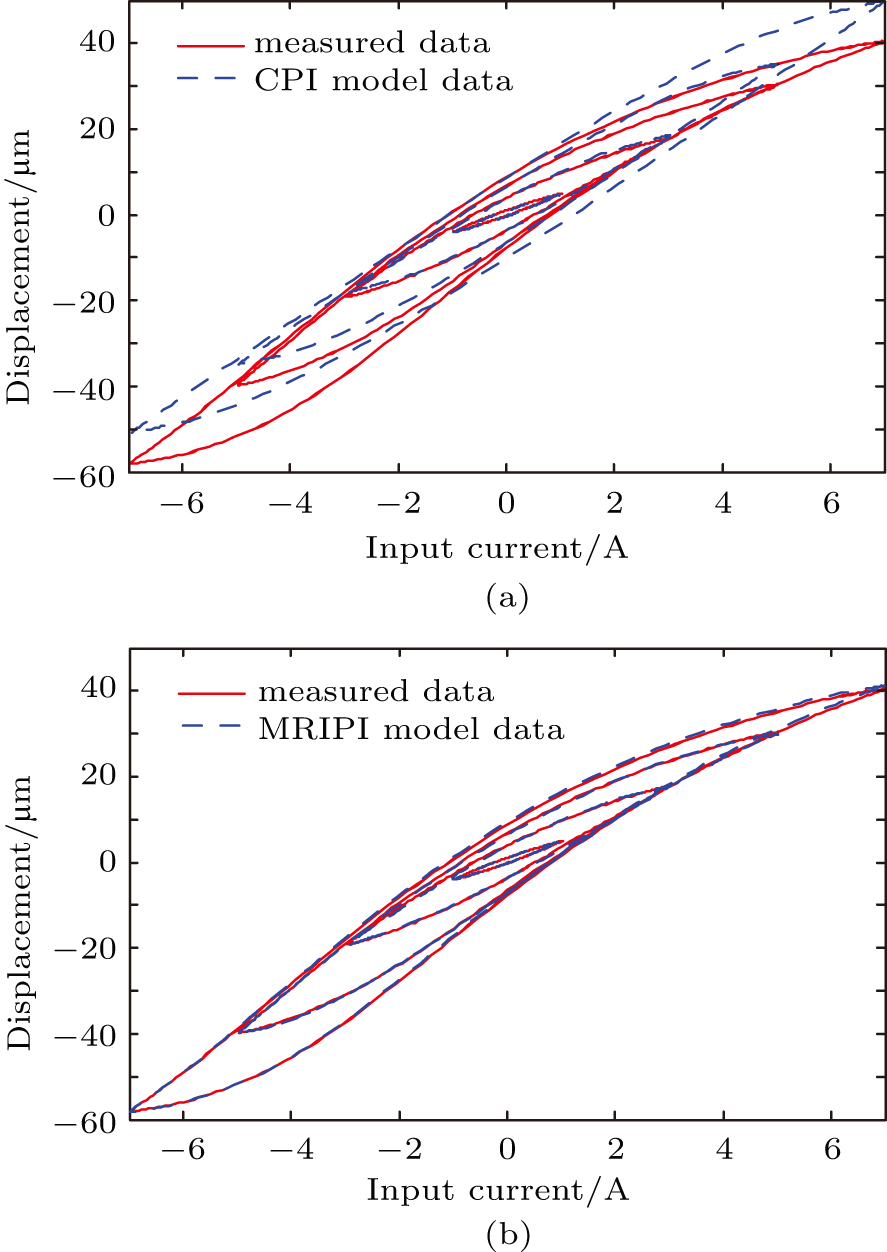 | Fig. 6. (color online) Performances of (a) CPI model and (b) MRIPI model when the amplitudes of the input current are 1 A, 3 A, 5 A, and 7 A. |
To further analyze the performance of the MRIPI model, the outputs of the MPI model and the GPI model are presented and compared with those of the MRIPI model. The input signal is the sinusoidal current with an amplitude of 3 A and a frequency of 10 Hz. In Fig.
Table
| Table 2.
Performances of the P–I models. . |
| Table 3.
Parameters of the P–I models. . |
The proposed modified classical Prandtl–Ishlinskii model identified by the VSCA can accurately characterize the asymmetric hysteresis behavior of magnetostrictive actuators. The performance of the MRIPI model is stable under different amplitudes of applied current. The relative root-mean-square error stays less than 1% and the relative maximum error stays less than 2% when the amplitudes of the input current increase from 1 A to 7 A. Compared with the classical Prandtl–Ishlinskii model, the proposed model has a better description of both the local and global asymmetric hysteresis behaviors exhibited by magnetostrictive actuators. Additionally, the proposed model has a relatively simple mathematic format with fewer parameters to be identified. Thus, it is more efficient to establish the MRIPI model and describe the asymmetric hysteresis phenomenon of magnetostrictive actuators. The performances of different Prandtl–Ishlinskii models are also compared to show better accuracies of the proposed model. The inverse model of the MRIPI model will be studied and the compensator control method of magnetostrictive actuators will be designed in the future.
| [1] | |
| [2] | |
| [3] | |
| [4] | |
| [5] | |
| [6] | |
| [7] | |
| [8] | |
| [9] | |
| [10] | |
| [11] | |
| [12] | |
| [13] | |
| [14] | |
| [15] | |
| [16] | |
| [17] | |
| [18] | |
| [19] | |
| [20] | |
| [21] | |
| [22] | |
| [23] | |
| [24] | |
| [25] | |
| [26] | |
| [27] | |
| [28] | |
| [29] | |
| [30] |


